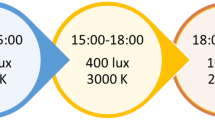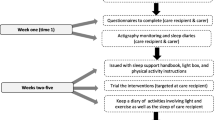Abstract
The body’s inability to regulate a 24-hour body clock can result in irregular patterns of sleep and wake and lead to an irregular sleep-wake rhythm disorder. This can present with insomnia and/or sleepiness. This condition is commonly seen in patients with neurodegenerative conditions such as dementia. Evidence-based treatment options for this condition are limited. Phototherapy in the morning has been shown to lead to some improvements. Other strategies such as environmental changes, exercise programs, and strategic avoidance of light have shown minimal benefit but because of the minimal risks associated with these options they could be tried in patients with irregular sleep-wake rhythm disorders.
Access this chapter
Tax calculation will be finalised at checkout
Purchases are for personal use only
Similar content being viewed by others
References
Urrestarazu E, Iriarte J. Clinical management of sleep disturbances in Alzheimer’s disease: current and emerging strategies. Nat Sci Sleep. 2016;8:21–33.
Hoch CC, et al. Sleep-disordered breathing in normal and pathologic aging. J Clin Psychiatry. 1986;47:499–503.
Dumitrache-Rujinski S, et al. The role of overnight pulse-oximetry in recognition of obstructive sleep apnea syndrome in morbidly obese and non obese patients. J Clin Med. 2013;8(3):237–42.
Aul EA, Davis BJ, Rodnitzky RL. The importance of formal serum iron studies in the assessment of restless legs syndrome. Neurology. 1998;51:912.
Bliwise DL. Periodic leg movements in sleep and restless legs syndrome: considerations in geriatrics. Sleep Med Clin. 2006;1(2):263–71.
Weldemichael DA, Grossberg GT. Circadian rhythm disturbances in patients with Alzheimers disease: a review. Int J Alzheimers Dis. 2010;2010:1–9.
Fong TG, et al. Delirium in elderly adults: diagnosis, prevention, and treatment. Nat Rev Neurol. 2009;5(4):210–20.
Pigeon WR, et al. Is insomnia a perpetuating factor for late-life depression in the IMPACT cohort? Sleep. 2008;31(4):481–8.
Ouslander JG, et al. A nonpharmacological intervention to improve sleep in nursing home patients: results of a controlled clinical trial. J Am Geriatr Soc. 2006;54(1):38–47.
Rogers SL, et al. Donepezil improves cognition and global function in Alzheimer disease. Arch Intern Med. 1998;158:1021–31.
Stopa EG, et al. Pathologic evaluation of the human suprachiasmatic nucleus in severe dementia. J Neuropathol Exp Neurol. 1999;58(1):29–39.
Swaab DF, et al. The suprachiasmatic nucleus of the human brain in relation to sex, age and senile dementia. Brain Res. 1985;342(1):37–44.
Bianchetti A, et al. Predictors of mortality and institutionalization in Alzheimer disease patients 1 year after discharge from an Alzheimer dementia unit. Dementia. 1995;6(2):108–12.
Uchida K, et al. Daily rhythm of serum melatonin in patients with dementia of the degenerate type. Brain Res. 1996;717:154–9.
Mccleery J, Cohen DA, Sharpley AL. Pharmacotherapies for sleep disturbances in dementia. Cochrane Database Syst Rev. 2016;11:CD009178.
Auger RR, Burgess HJ, Emens JS, Deriy LV, Thomas SM, Sharkey KM. Clinical practice guideline for the treatment of intrinsic circadian rhythm sleep-wake disorders: advanced sleep-wake phase disorder (ASWPD), delayed sleep-wake phase disorder (DSWPD), non-24-hour sleep-wake rhythm disorder (N24SWD), and irregular sleep-wake rhythm disorder (ISWRD). An update for 2015. J Clin Sleep Med. 2015;11(10):1199–236.
Riemersma-van der Lek RF, et al. Effect of bright light and melatonin on cognitive and noncognitive function in elderly residents of group care facilities. JAMA. 2008;299(22):2642.
Ray WA, et al. Atypical antipsychotic drugs and the risk of sudden cardiac death. N Engl J Med. 2009;360:225–35.
Alessi CA, et al. A randomized trial of a combined physical activity and environmental intervention in nursing home residents: do sleep and agitation improve? J Am Geriatr Soc. 1999;47:784–91.
McMurry SM, et al. Nighttime insomnia treatment and education for Alzheimer’s disease: a randomized, controlled trial. J Am Geriatr Soc. 2005;53:793–802.
Mishima K, et al. Morning bright light therapy for sleep and behavior disorders in elderly patients with dementia. Acta Psychiatr Scand. 1994;89(1):1–7.
Dowling GA, et al. Effect of timed bright light treatment for rest-activity disruption in institutionalized patients with Alzheimer’s disease. Int J Geriatr Psychiatry. 2005;20(8):738–43.
Fetveit A, et al. The effects of bright-light therapy on actigraphical measured sleep last for several weeks post-treatment. A study in a nursing home population. J Sleep Res. 2004;13:153–8.
Skjerve A, et al. Improvement in behavioral symptoms and advance of activity aerophase after short-term bright light treatment in severe dementia. Psychiatry Clin Neurosci. 2004;58:343–7.
Suggested Reading
Auger RR, Burgess HJ, Emens JS, Deriy LV, Thomas SM, Sharkey KM. Clinical practice guideline for the treatment of intrinsic circadian rhythm sleep-wake disorders: advanced sleep-wake phase disorder (ASWPD), delayed sleep-wake phase disorder (DSWPD), non-24-hour sleep-wake rhythm disorder (N24SWD), and irregular sleep-wake rhythm disorder (ISWRD). An update for 2015. J Clin Sleep Med. 2015;11(10):1199–236.
Author information
Authors and Affiliations
Corresponding author
Editor information
Editors and Affiliations
Rights and permissions
Copyright information
© 2019 Springer Nature Switzerland AG
About this chapter
Cite this chapter
Meinen, C., Kolla, B.P., Mansukhani, M.P. (2019). Wandering in the Nursing Home. In: Khawaja, I., Hurwitz, T. (eds) Comorbid Sleep and Psychiatric Disorders. Springer, Cham. https://doi.org/10.1007/978-3-030-11772-6_10
Download citation
DOI: https://doi.org/10.1007/978-3-030-11772-6_10
Published:
Publisher Name: Springer, Cham
Print ISBN: 978-3-030-11771-9
Online ISBN: 978-3-030-11772-6
eBook Packages: MedicineMedicine (R0)




